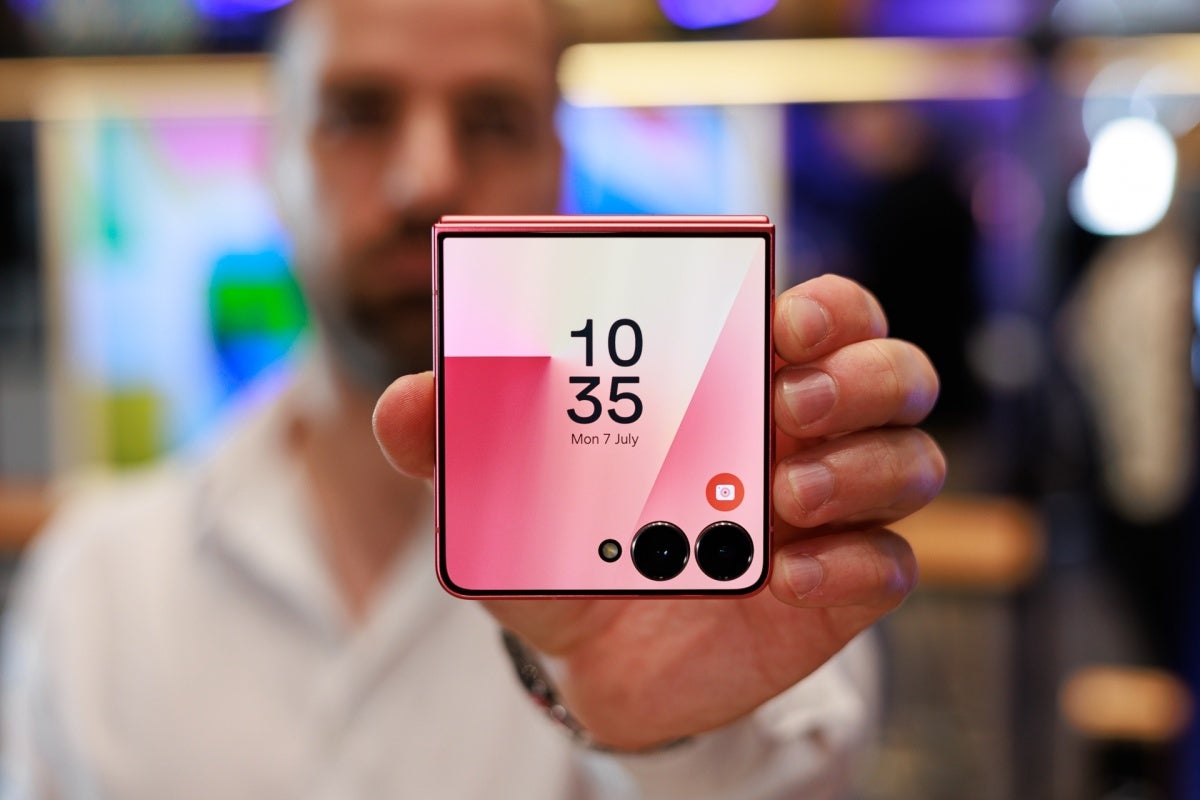

That huge cover screen is without a doubt one of the Z Flip 7’s biggest strengths. | Image Credit — PhoneArena
#Samsungs #Black #Friday #Early #Access #sale #slashes #towering #Galaxy #Flip
$799
99
$1099
99
$300 off (27%)
5G, 256GB Storage, 12GB RAM, Exynos 2500 Processor, Android 16, Galaxy AI, 6.9-Inch Dynamic AMOLED 2X Infinity Flex Display with 2520 x 1080 Pixel Resolution and 120Hz Refresh Rate Support, 4.1-Inch Super AMOLED Cover Screen with 1048 x 948 Pixel Resolution and 120Hz Refresh Rate Technology, 50 + 12MP Dual Rear-Facing Camera System, 10MP Front-Facing Camera, 4,300mAh Battery, 25W Wired and 15W Wireless Charging Support, IPx8 Water Resistance, Four Color Options, No Device Trade-In Required (Additional Discounts Available with Trade-In)
Buy at Samsung
$919
99
$1219
99
$300 off (25%)
5G, 512GB Storage, 12GB RAM, Exynos 2500 Processor, Android 16, Galaxy AI, 6.9-Inch Dynamic AMOLED 2X Infinity Flex Display with 2520 x 1080 Pixel Resolution and 120Hz Refresh Rate Support, 4.1-Inch Super AMOLED Cover Screen with 1048 x 948 Pixel Resolution and 120Hz Refresh Rate Technology, 50 + 12MP Dual Rear-Facing Camera System, 10MP Front-Facing Camera, 4,300mAh Battery, 25W Wired and 15W Wireless Charging Support, IPx8 Water Resistance, Four Color Options, No Device Trade-In Required (Additional Discounts Available with Trade-In)
Buy at Samsung


That huge cover screen is without a doubt one of the Z Flip 7’s biggest strengths. | Image Credit — PhoneArena
Mint Mobile is also offering an incredible bargain for those seeking unlimited data! The carrier’s latest deal lets you grab any unlimited plan for just $15/mo, bringing the 12-month Unlimited plan to $180 instead of $360.
Buy at Mint Mobile
Adrian, a mobile technology enthusiast since the Nokia 3310 era, has been a dynamic presence in the tech journalism field, contributing to Android Authority, Digital Trends, and Pocketnow before joining PhoneArena in 2018. His expertise spans across various platforms, with a particular fondness for the diversity of the Android ecosystem. Despite the challenges of balancing full-time parenthood with his work, Adrian’s passion for tech trends, running, and movies keeps him energized. His commitment to mid-range smartphones has led to an eclectic collection of devices, saved from personal bankruptcy by his preference for ‘adequate’ over ‘overpriced’.
Read the latest from Adrian Diaconescu
#Samsungs #Black #Friday #Early #Access #sale #slashes #towering #Galaxy #Flip
The Investigatory Powers Tribunal (IPT), an independent UK court that handles complaints against security agencies, released the filing. It suggests that the Home Office is still seeking access to data from users outside the UK.
Apple challenged the Home Office’s order in March, arguing that creating a backdoor into its cloud systems would undermine user privacy.
The IPT filing lists the “assumed facts” for next year’s court hearing. These are rules that let both sides prepare without breaking secrecy laws and aren’t confirmed as true. Apple first mentioned the order in February when it removed ADP encryption for UK users. But the filing shows the Home Office wants access to Apple’s regular iCloud too. This could include messages, passwords, and backups from users around the world, not just in the UK.
The UK Investigatory Powers Act gives authorities wide-ranging powers, theoretically allowing law enforcement to access data held anywhere in the world. Critics have labeled the law a “snooper’s charter”, while the UK maintains it is necessary for tackling terrorism and other crimes.
As the case moves toward court, questions remain over how far the UK can legally extend its surveillance powers and how this will affect the privacy of iCloud users worldwide.
This will only make things worse and even more people will lose faith in their governments. Last time when I reported on the Apple/UK saga, I asked this simple question, and the poll results speak for themselves:


Could that trend even be reversed?


“Iconic Phones” is coming this Fall!
Good news everyone! Over the past year we’ve been working on an exciting passion project of ours and we’re thrilled to announce it will be ready to release in just a few short months.
We may earn a commission if you make a purchase
Check Out The Offer
Read the latest from Sebastian Pier
#wanted #access #iPhones #previously #thought
YouTube TV subscribers could be set to lose access to content from media company Fox, including college football, unless the sides strike a new carriage deal.
With the current agreement between the sides nearing a renewal deadline, YouTube TV could pull Fox sports, business and news channels from its platform by 5 p.m. EST on Wednesday.
In a blog post, Google-owned YouTube said Fox was “asking for payments that are far higher than what partners with comparable content offerings receive.” The company added that it hoped to reach a deal that’s “fair for both sides” without “passing on additional costs to our subscribers.”
If Fox content becomes unavailable on YouTube TV “for an extended period of time,” YouTube also noted it would provide members with a $10 credit. YouTube TV’s base plan, which currently boasts access to over 100 live channels, costs $82.99 a month.
A spokesperson for Google did not have any additional comments when reached Wednesday by The Associated Press.
Fox said Wednesday that it was “disappointed that Google continually exploits its outsized influence by proposing terms that are out of step with the marketplace.” The broadcast giant added that it remained committed to reaching an agreement, but was alerting viewers that they could potentially lose access to Fox programming on YouTube TV “unless Google engages in a meaningful way soon.”
Fox directed subscribers to keepfox.com — a site noting that, in addition to Fox Sports, Business and News, YouTube TV may no longer carry FS1 and the Big Ten Network, which is majority-owned by Fox, if a deal isn’t reached.
Federal Communications Commission Chairman Brendan Carr has also chimed in on the dispute, urging Google to “get a deal done” in a social media post on Tuesday.
“Google removing Fox channels from YouTube TV would be a terrible outcome,” Carr wrote on X. “Millions of Americans are relying on YouTube to resolve this dispute so they can keep watching the news and sports they want — including this week’s Big Game: Texas @ Ohio State.”
Contractual disputes over carriage fees — the money that streaming, cable and satellite TV providers pay for platforms to carry their content — are common between TV networks and carriers like YouTube. Negotiations often go down to the wire and sometimes lead carriers to remove a broadcaster from their lineup if the sides fail to reach agreement. Channels are typically restored once a new carriage deal is struck.
In February, for example, YouTube TV clashed with Paramount Global over the terms of carrying the entertainment and media company’s content (Paramount Skydance owns CBS News.) The companies reached a deal in February.
YouTube TV is the largest streaming provider as measured by total time watched, according to Nielsen.
#YouTube #viewers #lose #access #Fox #channels #contract #dispute
This process, called forensic investigative genetic genealogy, or FIGG, has since helped solve hundreds of murders and sexual assaults. Still, while the technology is potent, it’s incompletely realized. It operates via a mishmash of private labs and unregulated websites, like FamilyTree, which give users a choice to opt into or out of police searches. The number of profiles available for search by police hovers around 1.5 million, not yet enough to find matches in all cases.
To do my bit to increase those numbers, I traveled to Springfield, Massachusetts.
The staff of the local district attorney, Anthony D. Gulluni, was giving away free FamilyTree tests at a minor-league hockey game in an effort to widen its DNA net and help solve several cold-case murders. After glancing over a consent form, I spit into a tube and handed it back. According to the promotional material from Gulluni’s office, I’d “become a hero.”
But I wasn’t really driven by some urge to capture distantly related serial killers. Rather, my spit had a less gallant and more quarrelsome motive: to troll privacy advocates whose fears around DNA I think are overblown and unhelpful. By giving up my saliva for inspection, I was going against the view that a person’s DNA is the individualized, sacred text that privacy advocates sometimes claim.
Indeed, the only reason FIGG works is that relatives share DNA: You share about 50% with a parent, 25% with a grandparent, about 12.5% with a first cousin, and so on. When I got my FamilyTree report back, my DNA had “matched” with 3,309 people.
Some people are frightened by FIGG or reject its punitive aims. One European genealogist I know says her DNA is kept private because she opposes the death penalty and doesn’t want to risk aiding US authorities in cases where lethal injection might be applied. But if enough people share their DNA, conscientious objectors won’t matter. Scientists estimate that a database including 2% of the US population, or 6 million people, could identify the source of nearly any crime-scene DNA, given how many distant relatives each of us has.
#gave #police #access #DNAand
